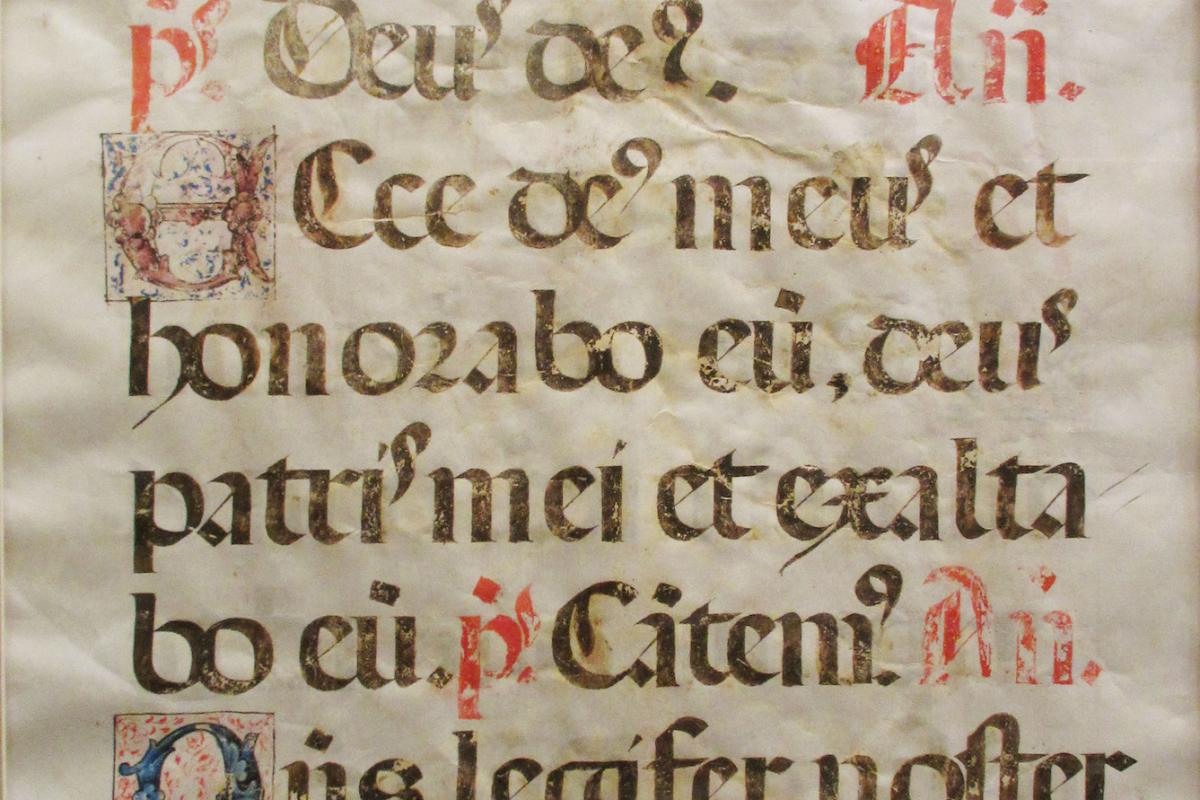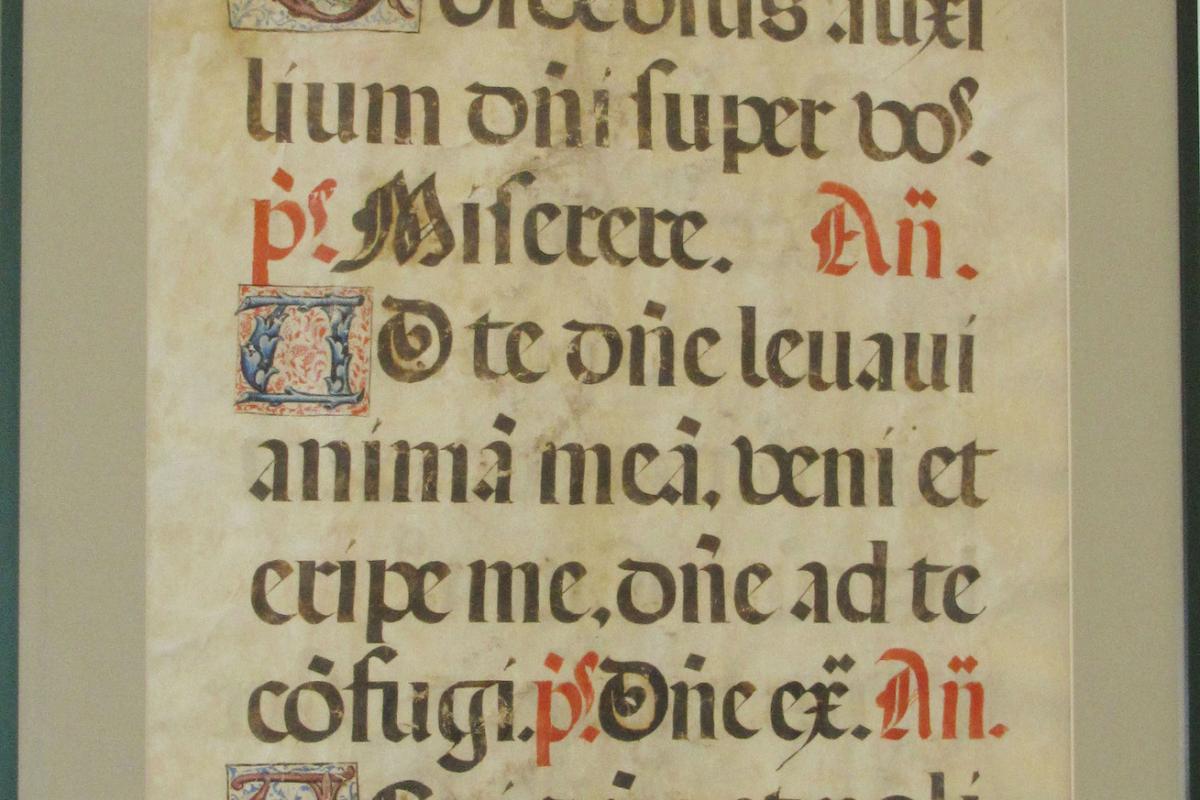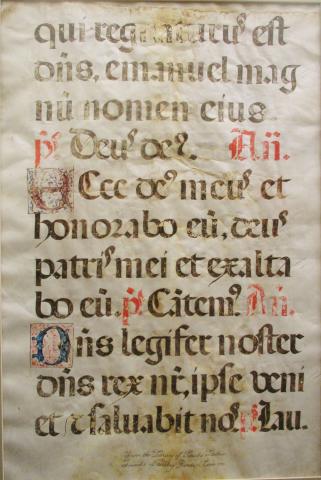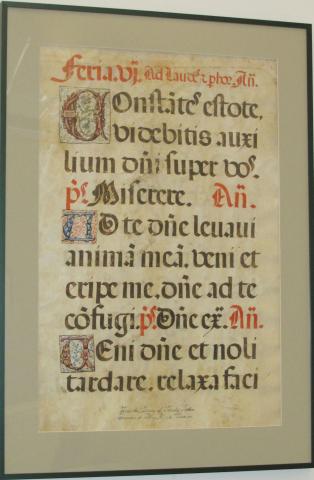Antiphonal Leaf
Antiphonal Leaf
Spanish, 16th century
Language: Latin
Single leaf
ink on vellum
height 85 cm
width 62 cm
Portland State University Library Special Collections
Mss 9, Rose-Wright Manuscript Collection no. 1
Music in the Middle Ages: Two Antiphonal Leaves
A description of two antiphonal leaves housed in the Millar Library Special Collections of Portland State University in Portland, Oregon. This video was made as part of the 2011 Medieval Portland Capstone taught by Professor Anne McClanan for the University Studies program.
Elaine Cash, Medieval Portland Capstone Student, 2015
This Spanish Antiphonal is a single leaf with chants written on both sides. An Antiphonal is a type of Liturgical book, comprised of the various chants used in a service. The print is large as well, and written in a round Gothic script. It is quite large, measuring 85 cm tall, and this large size was because it was meant to be read from a distance by a choir.
This antiphonal leaf was used for the Divine Office.[1] This was a daily ritual practice of chanting the psalms is called the Divine Office, encompassing all music, psalms and chants of a service, excluding the Mass.[2] Every day brought a cycle of eight devotional chants of the psalms, each of which is called an office, or a canonical hour.[3] This leaf is a part of a morning hour called Lauds. (See Appendix 1). The top of the verso reads, "Feria VI ad laudes et per horas." Written in red lettering, this Latin phrase marks the beginning of a new date of the liturgical season. The recto contains the last chants of Feria V (Thursday) of the fourth week of Advent. Feria is the term used for all the days except Sunday.[4] At the beginning of the verso, it moves into Feria VI (Friday) of the fourth week of Advent. The two sides of this leaf contain four full chants, and two partial chants.
At the end of each chant (canticle) is a notation for a Psalm, simply noted as "PS" in red lettering. Following the Psalm is an abbreviation denoting this is an Antiphon. The rest of the text is written in black, except for the illuminated initials. The initials of the different chants are decorated with floral motifs in blue, brown, green and red. The beginning "C" of the chant on the verso that begins "Constantes estotes..." is the largest decorated letter, and contains a tiny plaque inside the "C" with the letters "IHS." These letters are a common symbol for the name of Jesus Christ. Moreover, IHS is a symbol of the Jesuit order, which was started in 1540 by a Spanish man named Ignatius Loyola.[5] This could comfortably confirm that this leaf comes from sixteenth-century Spain.
At the bottom of both the verso and recto of the leaf is an inscription from a man named Stanley Slotkin, a collector in the middle part of the twentieth century. The inscription reads "From the Library of Stanley Slotkin, founder of Abbey Rents~ Circa 1150." This date is inaccurate. During the 12th century, the common style of script in Spain was Visigothic or Mozarabic, which is quite different than the gothic script on the Spanish Antiphonal leaf. By the sixteenth century, these older styles had been abandoned, and liturgical gothic script is widely seen.
While there are examples of parts of this leaf that are similar to other antiphonal leaves, this Spanish Antiphonal leaf is unique. It contains eleven lines of text alone without musical lines or notes. By contrast, another antiphonal from fifteenth-century Spain has twelve lines,[6] and a choral psalter from eighteenth-century Spain has fifteen lines.[7] Both of these examples use the same script as the Spanish Antiphonal leaf, though there are slight differences among them. The Portland State Spanish Antiphonal leaf uses abbreviations for some words, whereas the other two are written out fully, using no abbreviations. The Spanish Antiphonal leaf's initials are roundly rendered vegetal motifs. The last difference is of content. The Spanish Antiphonal leaf contains chants, and abbreviations for psalms and antiphons that were to be used for Lauds during the season of Advent, the two other Spanish examples contain only psalms written out in their entirety indicating that they were not used for the same purpose.
Appendix 1- Charts*
Chart 1
Sunday-Sunday I
Monday-Feria II
Tuesday-Feria III
Wednesday-Feria IV
Thursday-Feria V
Friday-Feria VI
Saturday-Feria VII
Chart 2[8]
Divine Office, or Canonical Hours:
Martins-(Second Coming) Theme of feast displaces the hour theme
Lauds-Praise: spiritual resurrection/ Resurrection of our Lord
Prime-Preparation for the day's work
Terce-Come, Holy Ghost / Descent of the Holy Ghost
Sext-Lead us not into temptation (sin) / Christ on the Cross
None-Perseverance / Last things
Vespers-Thanksgiving / Last Supper
Compline-Contrition, Protection for the night / Heavenly banquet, Our Lord in Gethsemane
*These charts were presented in table forat in the original document
Appendix 2: The Chants in Latin
First side
[De Sion veniet] qui regnaturus est dominus Emmanuel magnum nomen ejus.
Ecce deus meus et honorabo eum deus patris mei et exaltabo eum.
Dominus legifer noster dominus rex noster ipse veniet et salvabit nos.
Second side
Constantes estote videbitis auxilium domini super vos.
Ad te domine levavi animam meam veni et eripe me domine ad te confugi.
Veni domine et noli tardare relaxa faci[nora plebis tuae Israel.[9]
Notes
[1] Toledo Museum of Art, Medieval and Renaissance Music Manuscripts, xiii.
[2] Toledo Museum of Art, Medieval and Renaissance Music Manuscripts, (Toledo Museum of Art, 1953), xiii.
[3] Robert G. Calkins. "Service book." In Grove Art Online. Oxford Art Online. oxfordartonline.com.proxy.lib.pdx.edu/subscriber/article/grove/art/T077794. Accessed July 27, 2012.
[4] Benedictines of Solesmes, ed., The Liber Usualis, with Introduction and Rubrics in English (Tournai, Belgium & New York: Desclée, 1962), Liii.
[5] Ignatius Loyola," In Grove Art Online. Oxford Art Online, oxfordartonline.com.proxy.lib.pdx.edu/subscriber/article/grove/art/T039896. Accessed August 8, 2012.
[6] University of California, Berkeley, Bancroft Library BANC MS UCB 130:ff1400:53, from Digital Scriptorium, Accessed August 9, 2012. app.cul.columbia.edu:8080/exist/scriptorium/individual/CU-BANC-276.xml?
[7] New York, Columbia University, Rare Book and Manuscript Library Western MS 78, from Digital Scriptorium, Accessed August 9, 2012. app.cul.columbia.edu:8080/exist/scriptorium/individual/NNC-RBML-1546.xml?
[8] Commentary on the Breviary, Accessed August 2, 2012. breviary.net/comment/commenthours.htm.
[9] Cantus Database Search, Accessed August 2, 2012. bach.music.uwo.ca/cantus/search.asp.
Wilma Fitzgerald, PhD, SP - Quoted with permission from an unpublished study
Antiphonale. Feria vi ad laudes et per horas. Adventus. Saec. XVI. Spanish?Verso of one vellum leaf framed in glass, untrimmed 850 x 620 (650 x 430) mm. Recto is unavailable. Sewing on left lower edge and upper right edge. Rough edging on binding side. One column, ten lines and a title. Initials:
C[onstantes] of leaves. In the bow of the C a small placque with the letters IHS (105 x 100 mm.); A[d] blue leaf pattern on a scattered red floral ground (65 x 70 mm.); V[eni] a reddish floral leaf on blue ground (70 x 70 mm.). All are enclosed with straight lines. At the bottom of the folio in modern hand (with erroneous dating): From the Library of Stanley Slotkin Founder of Abbey Rents circa 1150.
// Constantes estotes, uidebitis auxilium domini super vos. Ps. Miserere. An. Ad te domine leuaui animam meam. ueni et eripe me, domine ad te confugi. Ps. Domine exaudi. An. Veni domine et noli tardare relaxa faci[nora plebis tuae] //




